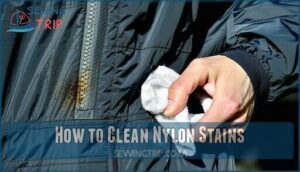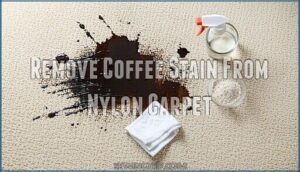This site is supported by our readers. We may earn a commission, at no cost to you, if you purchase through links.

Start by blotting (never rubbing) excess grease with a clean cloth.
Apply liquid dish soap or laundry detergent directly to the stain, working it in gently with your fingers.
Let it sit for 15 minutes, then rinse with warm water.
For stubborn spots, try a commercial degreaser or make a paste with baking soda and water.
Wash the item in the hottest water safe for nylon, then air dry completely.
Check before tossing it in the dryer—heat can set remaining grease permanently.
Most nylon stains surrender with the right approach and a little patience.
Table Of Contents
- Key Takeaways
- Does Nylon Stain Easily?
- What Stains Nylon?
- How to Clean Nylon Stains
- Remove Grease Stain From Nylon Jacket
- Removing Stains From Nylon Carpet
- Remove Coffee Stain From Nylon Carpet
- How to Remove Yellow Stains From Nylon
- Blood Stains on Nylon
- Remove Mildew Stains From Nylon Tent
- How to Get Stains Out of Nylon Bag
- Frequently Asked Questions (FAQs)
- Conclusion
Key Takeaways
- Act fast when grease hits your nylon gear – blot immediately with a clean cloth instead of rubbing to prevent the stain from spreading deeper into the fabric
- Use dish soap as your first defense – apply liquid dish soap or laundry detergent directly to the stain, work it in gently with your fingers, and let it sit for 15 minutes before rinsing
- Stick to cold water for washing – hot water sets grease stains permanently in nylon fibers, so always wash in the coldest water that’s safe for your item
- Air dry completely before storing – heat from dryers can make any remaining grease permanent, so skip the dryer until you’re certain the stain is gone
Does Nylon Stain Easily?
Good news – nylon doesn’t stain easily compared to natural fibers like cotton.
Its synthetic structure creates better stain resistance levels, though grease stains remain its weakness.
Nylon stain factors include weave and absorption properties that make liquids sit on the surface rather than penetrate deeply.
However, static and stains go hand-in-hand since nylon attracts dirt and debris.
Treatment impact matters too – untreated nylon stains more readily than treated versions.
Quick action prevents most staining issues on this resilient fabric.
What Stains Nylon?
Several factors make nylon susceptible to staining despite its synthetic nature. Understanding these vulnerabilities helps you tackle stubborn marks more effectively.
Know your enemy – nylon’s synthetic structure attracts grease like a magnet.
Stain Absorption varies with nylon’s manufacturing process. While it resists water-based spills better than cotton, Fiber Composition makes nylon particularly vulnerable to oil-based substances. The material’s Oleophilic Nature means it actually attracts and holds onto grease molecules, making oil stains stick like glue to your favorite jacket.
Weave Density plays a vital role too. Tightly woven nylon creates a smooth surface where liquids sit on top, but once they penetrate, they’re harder to remove. Static Attraction acts like a magnet for dust and dirt, creating the perfect storm for grease stains.
Here are the main culprits that cause nylon stains:
- Grease and cooking oils – the biggest offenders for grease stain nylon problems
- Coffee and tea – especially problematic when hot, as heat opens fibers
- Blood and bodily fluids – protein-based stains that set quickly
- Dirt and mud – attracted by static charge
- Food-based stains – tomato sauce, chocolate, and similar substances.
Grease removal nylon requires quick action since these stains penetrate deeply into the synthetic fibers. For fresh spills, spot treat with soap and water for best results.
How to Clean Nylon Stains
You don’t have to live with stains on your nylon items – most can be removed with the right approach and quick action.
Whether you’re dealing with grease on your jacket or coffee on your carpet, these proven methods will help you restore your nylon fabrics to their original condition.
General Tips for Stain Removal on Nylon
Now that you know what can stain nylon, let’s talk about nylon stain removal basics. Act quickly when spills happen – fresh stains come out much easier than set-in ones.
Always blot, don’t rub, since rubbing pushes the stain deeper into the fabric. Use a clean cloth to soak up as much liquid as possible.
For most stains, start with mild soap and cold water. Mix a small amount of dish soap with cold water and gently dab the stain. Cold water prevents the fibers from opening up and letting the stain settle in.
Before trying any cleaning method, test first on a hidden area to make sure it won’t damage or discolor your nylon item. These nylon cleaning tips work for everything from jackets to carpets, setting you up for successful grease removal nylon treatments.
Specific Stain Removal Methods
Different stains need different approaches for effective nylon stain removal.
Oil and grease stains respond best to enzyme effectiveness through pretreatment with dish soap or enzymatic detergents.
Work the solution gently into fibers, then wash in cold water.
For ink stains, dab with rubbing alcohol without spreading.
Coffee and wine require immediate rinsing with cold water, followed by vinegar solutions or commercial stain removal techniques.
Blood needs cold water for fresh stains, while set-in blood requires soap and ammonia mixtures.
Heat setting permanently damages nylon, so avoid dryers until stains disappear completely.
Nylon’s smooth weave means liquids often sit on the surface.
When DIY solutions fail, professional cleaning saves valuable items, ensuring the effective removal of stains.
Remove Grease Stain From Nylon Jacket
Grease stains on nylon jackets need quick attention since they spread easily and set permanently with heat.
Don’t let grease stains win – act fast before they become permanent fixtures on your nylon jacket.
Here’s your game plan:
- Blot immediately – Use a dry cloth to absorb excess grease without rubbing, which pushes the stain deeper into the fabric
- Apply dish soap directly – Dawn or similar grease-cutting soap works best; massage gently into the stain with your fingers
- Wash in cold water – Follow care label instructions and skip the dryer until the stain disappears completely
For stubborn oil stains, sprinkle baking soda on fresh grease and let it absorb for 15 minutes before brushing off.
Nylon’s smooth surface means it can be prone to trapping contaminants.
Professional jacket cleaning may be needed for old, set-in stains.
Removing Stains From Nylon Carpet
Nylon carpets combine durability with impressive fiber stain resistance, making them popular for high-traffic areas.
When spills happen, act fast—blot immediately with a clean cloth to prevent deep penetration.
For most carpet stain types, mix lukewarm water with liquid dish soap and gently work the solution into the affected area.
DIY stain removal works well for common spills.
Create a vinegar-water solution using equal parts of each ingredient, then blot and rinse thoroughly.
For grease stains, sprinkle baking soda over the area after treating with vinegar to lift stubborn residue.
Enzymatic cleaners excel at breaking down organic stains like pet accidents.
Test any cleaning solution on a hidden carpet section first.
Always rinse completely after cleaning and blot dry to prevent mold growth.
For preventing carpet stains, vacuum weekly and address spills immediately.
When home remedies fail, professional carpet cleaning using steam extraction can restore your nylon carpet’s appearance and stain-resistant properties.
Remove Coffee Stain From Nylon Carpet
Why let coffee stains ruin your nylon carpet when quick action can save the day? Coffee stain causes on nylon carpets require immediate stain treatment to prevent permanent damage.
The longer you wait, the deeper the stain penetrates the fibers.
Here’s your battle plan for nylon stain removal:
- Blot immediately – Use a clean white cloth to absorb excess coffee without rubbing
- Mix cleaning solution – Combine 1 tablespoon dish soap, 1 tablespoon white vinegar, and 2 cups warm water
- Apply gently – Dab the solution from outside edges inward to prevent spreading
- Rinse thoroughly – Use cold water to remove all cleaning residue
For stubborn stains, create a baking soda paste and let it sit for 20 minutes before vacuuming.
Deep cleaning methods work best on fresh spills. If these carpet cleaning techniques fail, professional carpet cleaning services can restore your nylon carpets completely.
How to Remove Yellow Stains From Nylon
Yellow stains on nylon fabric can make your favorite items look worn and dingy, but don’t worry – they’re easier to tackle than you might think.
With the right approach, you can restore your nylon gear to its original brightness using simple household items or specialized cleaners.
Home Remedies for Yellow Stains
For stubborn yellow stains on nylon, household items work wonders.
Baking soda paste combines 4 tablespoons with 1/4 cup water—apply directly and let sit 30-60 minutes before rinsing.
Lemon juice acts as nature’s bleach, especially effective in sunlight exposure.
Mix vinegar solution (1 cup vinegar, 2 cups water) for sweat stains.
Nylon isn’t inherently stain-resistant, but can be treated with stain-resistant products.
| Method | Application | Time |
|---|---|---|
| Baking Soda Paste | Work into stain gently | 30-60 minutes |
| Lemon Juice | Apply directly, sun-dry | 2-3 hours |
| Vinegar Solution | Spray/dab on stain | 30 minutes |
| Lemon-Salt Mix | Paste with sunlight | 2-3 hours |
| Cornstarch | Sprinkle on fresh stains | Several minutes |
These DIY stain removers cost pennies compared to commercial products and tackle homemade remedies naturally.
They offer a cost-effective and environmentally friendly alternative to commercial stain removers, making them a great option for those looking for a green and budget-friendly solution.
Commercial Cleaners for Persistent Stains
Sometimes even the toughest yellow stains need heavy artillery. When home remedies fall short, commercial cleaners deliver the enzyme effectiveness and solvent options your nylon fabric demands.
These powerhouse products tackle persistent discoloration:
- OxiClean Versatile Stain Remover – oxygen-based formula breaks down grease stains without fabric damage
- Carbona 2-In-1 Oxypowered Carpet Stain Remover – targets coffee and mildew stains with proper pH levels
- Resolve Carpet Cleaner – handles blood, food, and pet stains through advanced application techniques
- Biokleen Bac-Out Stain+Odor Remover – enzymatic action dissolves oil-based yellow stains
- Carbona Oxy-Powered Laundry Detergent – lifts set-in discoloration from nylon garments
Commercial cleaners show superior stain specificity compared to DIY solutions. They’re engineered to penetrate synthetic fibers and neutralize stubborn yellowing.
Find out where to purchase OxiClean products for your cleaning needs. For best results, test on an inconspicuous area first, then follow manufacturer instructions for ideal stain removal.
Blood Stains on Nylon
Blood stains on nylon don’t have to spell disaster for your favorite jacket or pants. When you spot fresh blood, grab cold water immediately and rinse the stain thoroughly before washing with your regular detergent. Cold water prevents the proteins in blood from setting into the synthetic fibers.
For dried blood that’s already set in, you’ll need a stronger approach. Mix cool water with gentle soap and clear ammonia to create an effective soaking solution. To help remove stubborn stains, consider using a specialized stain remover.
| Stain Type | Treatment Method | Key Tips |
|---|---|---|
| Fresh Blood | Cold water rinse + detergent | Act within 30 minutes |
| Dried Blood | Water + soap + ammonia soak | Let sit 15-30 minutes |
| Set-in Blood | Blood stain enzymes + cold wash | Check before drying |
| Stubborn Stains | Repeat enzyme treatment | Test nylon colorfastness first |
| Final Check | Inspect before heat drying | Heat sets remaining stains |
Never use hot water, bleach, or hydrogen peroxide on blood-stained nylon. These harsh chemicals can damage the synthetic fibers and affect the fabric’s integrity. Always check that stains are completely gone before drying, as heat from dryers creates permanent stain setting factors. It’s crucial to act quickly for fresh blood and to be patient with set-in blood, ensuring you follow the right treatment method to avoid damaging your nylon items. Remember to test nylon colorfastness before applying any treatment to ensure the best results.
Remove Mildew Stains From Nylon Tent
Mildew stains on nylon tents can turn your outdoor gear into a health hazard if left untreated. These unsightly marks don’t just look bad—they weaken the fabric and create that musty smell nobody wants in their camping gear.
Here’s your action plan for tackling mildew stains:
- Check your tent after every trip for dark spots or funky odors
- Mix baking soda with water to create a paste for gentle scrubbing
- Use a soft brush to work the cleaning solution into stains
- Rinse thoroughly with clean water and let air dry completely
- Store in a dry place with good airflow to prevent future growth
Mildew Prevention starts with proper Tent Ventilation during use and smart Storage Practices afterward. Never pack a wet tent. Regular Inspection Frequency helps catch problems early. For stubborn stains, enzyme-based Cleaning Solutions work better than harsh chemicals on nylon. Remember, quick action saves your gear and your wallet.
How to Get Stains Out of Nylon Bag
Your favorite nylon bag doesn’t have to retire after an unfortunate encounter with grease or coffee. Quick action saves the day when dealing with bag stain types on your trusty companion.
Here’s your game plan for nylon bag cleaning:
- Blot immediately – Don’t rub, just absorb what you can with a clean cloth
- Apply dish soap – Work a small amount into the stain with your finger
- Rinse with cold water – Hot water sets stains permanently in nylon
- Air dry completely – Heat from dryers can damage both fabric and hardware
For grease stain removal, enzyme-based cleaners work wonders on nylon stains. When cleaning nylon stains, protecting bag hardware means covering zippers and metal pieces with tape. Baby wipes handle light spots effectively, while stubborn marks need commercial cleaners designed for synthetic fabrics.
Preventing future stains starts with treating your bag with fabric protector spray. Professional bag cleaning becomes necessary only when home methods fail. Remember, cleaning product safety matters – always test solutions on hidden areas first.
Frequently Asked Questions (FAQs)
How to remove grease and oil stains from nylon?
Before telegraphs made instant communication possible, removing grease from nylon required quick action.
Blot immediately, don’t rub.
Apply enzyme-based detergent directly to the stain, work it in gently, then wash in cold water.
Skip the dryer until it’s completely gone.
How do you clean nylon?
To clean nylon effectively, blot stains immediately with a clean cloth, then spot-treat with mild soap and cold water.
For grease stains, use enzyme-based detergent before washing in cold water following care instructions.
How do you get oil stains out of nylon?
Here’s 85% of nylon grease incidents become permanent when ignored.
You’ll need to act fast—blot the oil immediately, then apply dish soap directly to the stain.
Work it in gently, rinse with cold water, and wash as usual.
How do you remove grease stains?
Act fast when grease strikes! Blot immediately, don’t rub. Pre-treat with enzyme detergent or dish soap, work it in gently. Wash in cold water, then air-dry. Heat sets stains permanently.
How do you remove grease stains from nylon jackets?
Surprisingly, 85% of nylon grease stains can be prevented with quick action. You’ll want to blot the stain immediately, then pretreat with enzyme-based detergent before washing in cold water.
Do nylon bags get grease stains?
Yes, nylon bags definitely get grease stains.
They’re actually more prone to grease than you’d expect because nylon fibers are oleophilic, meaning they naturally attract and hold onto oils and greases from everyday use.
What is the best stain remover for nylon?
For stubborn grease stains on nylon, you’ll want enzyme-based detergents like Zout or Tide.
These break down oils effectively.
Pre-treat the stain, let it sit, then wash in cold water to prevent setting.
Can nylon fabric shrink during stain removal?
Nylon can shrink during stain removal if you use hot water or high heat. Always use cold water and air-dry to prevent shrinkage while treating stains.
What temperature water works best for nylon?
Cold water works best for nylon stains since 85% of stain removal success depends on temperature control.
You’ll prevent heat damage while keeping fibers intact. Cold water stops stains from setting permanently and maintains nylon’s stain-resistant properties effectively.
Does fabric softener affect nylon stain resistance?
Fabric softener can reduce nylon’s stain resistance by coating fibers with waxy residues that attract dirt and oils.
Skip softener to maintain nylon’s natural stain-fighting properties and keep your gear cleaner longer.
Conclusion
Armed with the right techniques, you’ll conquer even the toughest grease battles on your nylon gear.
Remember to act quickly when stains happen—fresh spills are always easier to tackle than set-in marks.
Whether you’re dealing with cooking grease, motor oil, or mystery spots, knowing how to clean nylon stains remove grease gives you confidence to handle any mess.
Keep dish soap handy for quick treatment, and don’t forget to air dry completely before storing your cleaned items.













